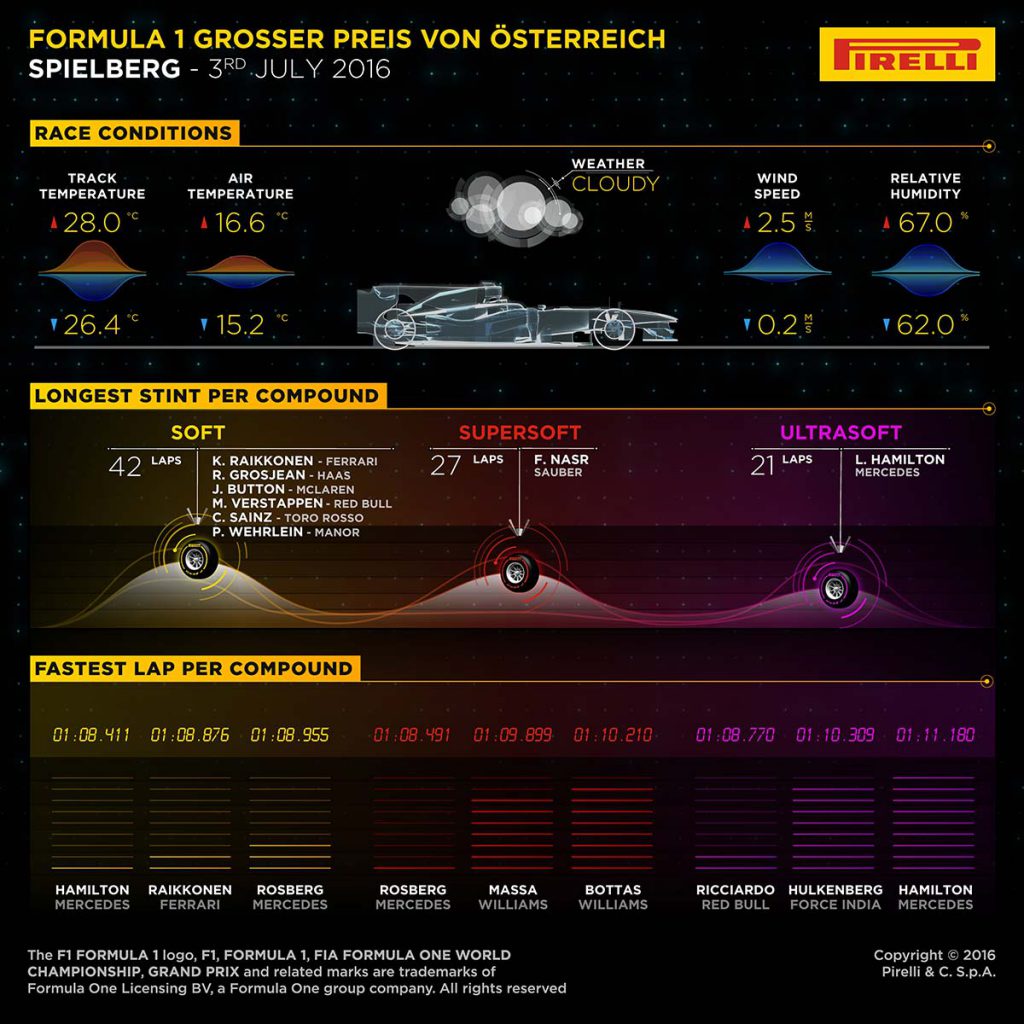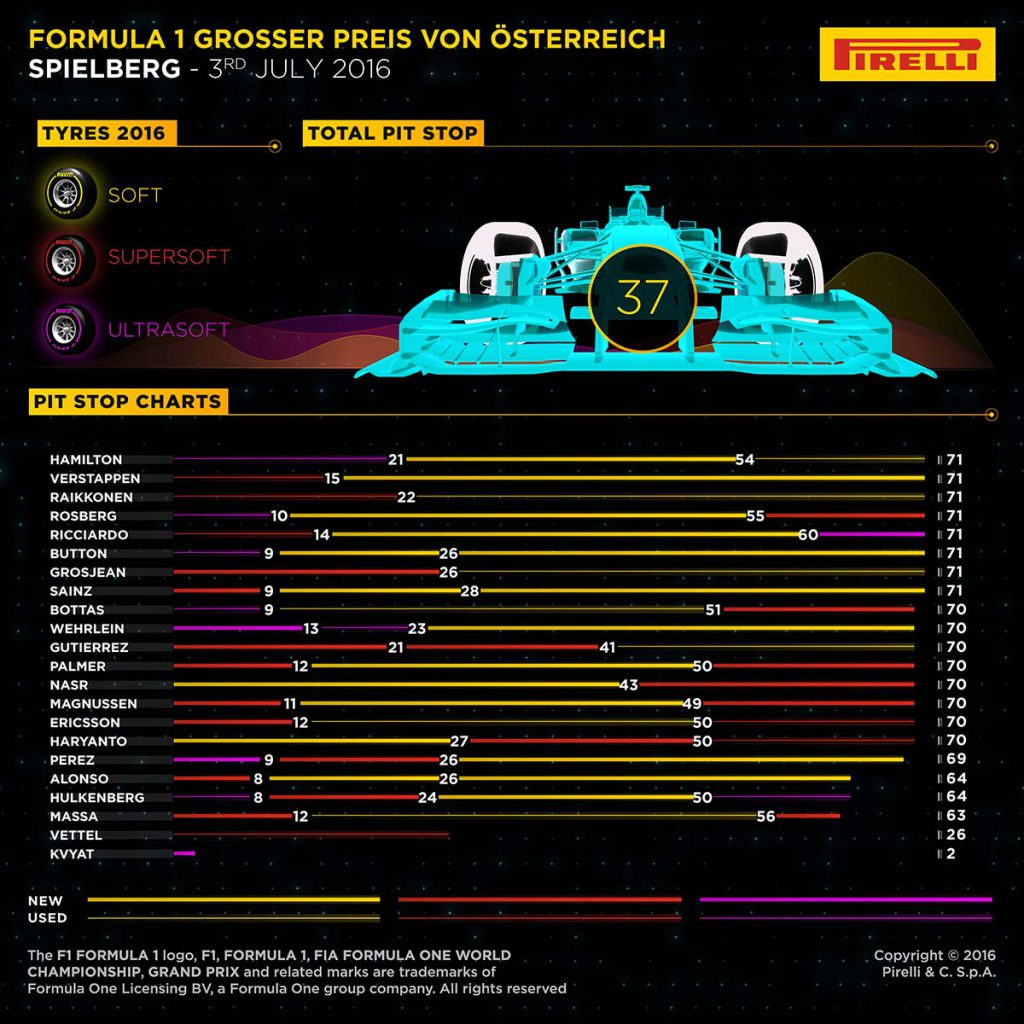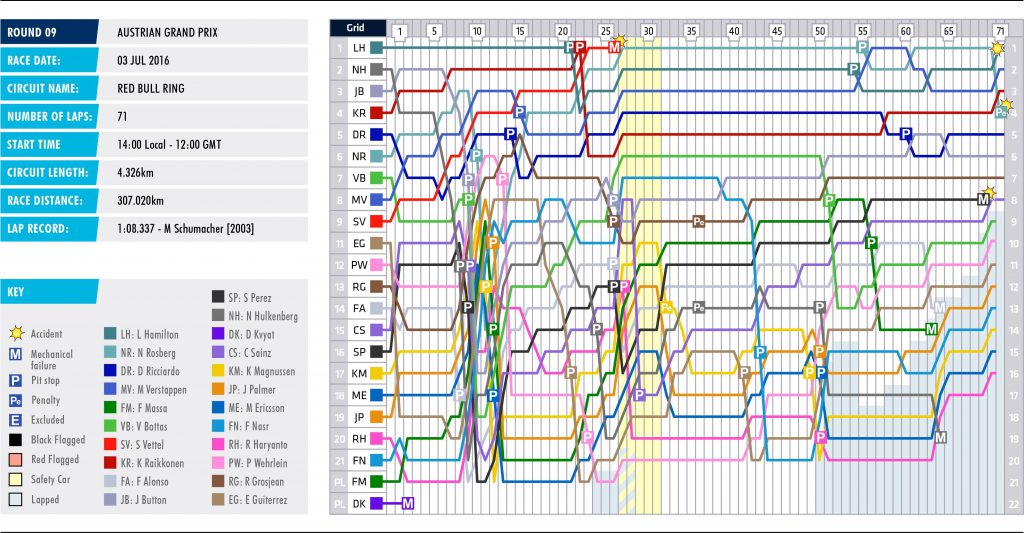Austrian Grand Prix 2016
4 Jul 2016
Race 9 – 71 Laps – 4.362km per lap – 307.020km race distance – medium tyre wear
Austrian GP F1 Strategy Report Podcast – our host Michael Lamonato is joined by Ted Kravitz from Sky Sports F1 in an extra long (and extra insightful!) episode.
Formula 1 returned to the Red Bull Ring in Spielberg, Austria, for round nine of the 2016 season. The breathtaking scenery and backdrop at the undulating circuit were matched by a truly frenetic race, which featured some very interesting strategy points.
Lewis Hamilton stormed to win number three of the year, following a last-lap overtake (which involved the now infamous contact) on team-mate Nico Rosberg. Max Verstappen and Kimi Raikkonen completed the podium. There were a number of major strategy headlines to emerge from the race.
Teams play the Q2 game
All three Pirelli tyre compounds were used for the start of the race, with Rio Haryanto and Felipe Nasr opting for the softs, a large majority of the drivers who qualified from 11-22 on the super-soft and most of the top 10 on the ultra-soft.
But we also saw a few drivers who made it through to Q3 go for a fastest lap in Q2 on the middle tyre compound, the super-soft. Drivers in the top 10 start on the tyre they set their best time on in the second segment and Daniel Ricciardo, Kimi Raikkonen, Max Verstappen, Felipe Massa and Sebastian Vettel all setting going for this strategy.
With little difference between the ultra and super-soft tyres in terms of pace, it meant they could run at similar speeds to those on the softest compound while having a more durable tyre to work with. But overall it fell a bit flat for those trying to make it work, some made it work better than others but for one driver it didn’t work out at all…
Vettel goes long
Vettel opted for a long first stint on the super-soft tyre to see how much progress he could make from ninth on the grid after his gearbox penalty. He was running in the lead and was running decent pace, despite the softer compounds not lasting that long in Austrian GP practice. But it all ended in tears on lap 26 when his right-rear tyre exploded on the main straight. Pirelli is still investigating the issue, it was side of the car that gets the least load, so many feel it was not due to wear but perhaps debris. We will wait and see.
The Ultrasofts last
In practice many drivers were struggling with tyre graining and higher degradation than expected but this proved to not be the case on Sunday, with many managing long stints. One of these drivers was Hamilton, who did 21 laps in total on the ultrasofts in his opening stint.
With the tyre working well, Mercedes kept him out far longer than team-mate Nico Rosberg. Perhaps, with spits of rain falling, they were seeing what the weather would do or if a safety car would emerge. It did – for Vettel’s crash – but not in time for his stop. Still, it made you think once again, could Pirelli go even softer with this top of the range tyre?
It’s also worth noting many drivers pitted under the safety car and the brief pause in the race helped some to eke out their stints and save having to stop again or fall into tyre trouble at the end of their runs.
Rosberg vs Hamilton
This was a fascinating part of the race. Despite Hamilton’s ultra-softs lasting long, Rosberg managed to get the undercut with some seriously quick laps on the soft, which helped him move ahead of Hamilton when the British driver emerged from his stop.
Mercedes opted to keep Rosberg out until lap 55 before stopping again, a very considerable stint on the hardest of the three tyres. Hamilton had managed to cut the gap to his team-mate during this time due to his fresher tyres and both stopped again for the second time.
This time Hamilton pitted first and moved a bit closer when Rosberg emerged but they were on different tyres, the former on the softs and the latter on the super-soft. It was puzzling but the cooler temperature didn’t work as well for the super-softs and Hamilton was able to close in and eventually try an overtake on the final lap.
We all know what happened with the contact and Rosberg was handed penalties for the crash and continuing to the flag with a damaged car. It was unusual to see the super-soft not working as well and Hamilton being able to challenge on the harder compound, the temperatures and track conditions certainly played a crucial role in how the tyres worked and how different they worked compared to practice.
Ricciardo loses out
Both Red Bulls started on the super-soft, with Ricciardo lining up fifth and Verstappen eighth. But it was the 18-year-old star who proved the quicker of the two during the race, with Ricciardo struggling more with the tyres, to get them up to temperature and make them last.
It was never going to be a particularly strong track for Red Bull despite it being the team’s home circuit, but Verstappen enjoyed much better performance on the tyres – maybe just through a better set-up with the condition changes – and he worked his way up the order with some extremely long stints.
He only stopped once, whereas Ricciardo pitted twice, and did some feisty defending from Raikkonen late on. Meanwhile Ricciardo lost ground throughout the race with his tyre struggles and ended up fifth, just ahead of Jenson Button.
Wehrlein scores a point
Arguably the most heart warming story of the race was Pascal Wehrlein scoring a point for Manor in P10, just behind Valtteri Bottas. He qualified in P12 and had two strong, short stints on the ultra-soft early on, pitting for the final time just before the safety car. Despite recent rear deg struggles Wehrlein completed a brilliant final stint on the softs and was quick right through to the end.
Jack Leslie @JackLeslieF1
Longest Stints
Soft: Raikkonen, Grosjean, Button, Verstappen, Sainz, Wehrlein (42 laps)
Supersoft: Nasr (27 laps)
Ultrasoft: Hamilton (21 laps)
Most Stops
Hulkenberg (5 – including drive-throughs)
All the Data
Thanks to Pirelli Motorsport for the detailed infographics


Stints by Driver
|
|
||||||||||||||||||||||||||||||||||||||||||||||||||||||||||||||||||||||||||||||||||||||||||||||||||||||||||||||||||||||||||||||||||||||||||||||||||||||||||||||||||||||||||||||||||||||||||||||||||||||||||||||||||||||||||||||||||||||||||||||||||||||||||||||||||||||||||||||||||||||||||||||||||||||||||||||||||||||||||||||||||||||||||||||||||||||||||||||||||||||||||||||||||||||||||

SPIELBERG, AUSTRIA – JULY 02: Max Verstappen of the Netherlands driving the (33) Red Bull Racing Red Bull-TAG Heuer RB12 TAG Heuer on track during final practice for the Formula One Grand Prix of Austria at Red Bull Ring on July 2, 2016 in Spielberg, Austria. (Photo by Dan Istitene/Getty Images)


 Safety Car
Safety Car 3. Ricciardo
3. Ricciardo 5. Vettel
5. Vettel 6. Rosberg
6. Rosberg 8. Grosjean
8. Grosjean 9. Ericsson
9. Ericsson 11. Perez
11. Perez 14. Alonso
14. Alonso 19. Massa
19. Massa 20. Magnussen
20. Magnussen 26. Kvyat
26. Kvyat 88. Haryanto
88. Haryanto
